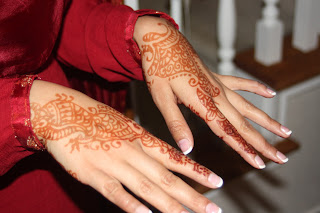The Rasm-e-Mehndi is
all about celebration. Many will be surprised to know how common this custom is
through-out the world. Middle Eastern brides and North African and Indian,
whether Jewish Christian Muslim Jain or Sikh are showered with a Mehndi Party
(Henna) a few days before the wedding. The only difference I have noticed is
that the designs made with the Henna (Mehndi) varies greatly from culture to
culture.
In some Jewish
circles, a cloth is used as a motif and the henna is applied on it, and
family members are encouraged to bring different motifs with some emotional significance.
In India, each
artist will go to elaborate lengths to draw finely drawn original designs on
the arms and legs of the Bride. With special attention given to the hands and
feet because whereas the forearm or the legs may be hidden by garments,
the hands and feet of the Bride are always visible.
A Mehndi party has two
aspects to it. One is the actual application of the Mehndi and the other is the
party. The two are held 24 hours apart which is how long it takes for the
Mehndi that is applied to dry and set on the body of the applicant.
For the first party -
the Mehndi application get together - you may need lots of pillows because most
desi’s will sit on the floor and recline against the pillow for support. The
pillow covers should be in as bright colors as you can find, usually yellow and
greens. The bride will be waited on and will be encouraged to sit back and
relax.
TIP: Get a painter’s
style large plastic sheet - available at hardware stores e.g. Home Depot - this
will prevent the carpet from requiring cleaning because after the henna dries,
it falls off the skin in small pieces and gets into all sorts of nooks and
crannies. You will need a vacuum cleaner to clean up later.
When the bride and
guest have had Mehndi applied to their hands and feet and it is still wet, all
of them will be holding their hands in the air avoiding their henna designs
from getting ruined. And pretty soon they will realize they are hungry. So make
arrangements for easy to eat food, like finger foods, since many guests would
rather not tempt fate and eat a regular meal of roti and Desi food which may
require them washing their hands or otherwise ruin their beautiful designs of Mehndi.
Stick with sandwiches
and kabob rolls, pakora’s and Samosa’s etc., accompanied by such
perennial favorites as Mango juice or Mango shakes and or Faluda or something
similar. There may be a youngster or two wanting a coke, so keep some soft
drinks on hand as well.
And for Desi’s, tea is always a good idea
especially after food, to negate any food comma or revive flagging energy
levels. Make a pot full but only when people are ready to drink so that it is
fresh and does not have that long festering stale taste. Attention to detail is
important to keep your guests happy. Cold tea tastes terrible and the only thing
worse is reheated tea.









